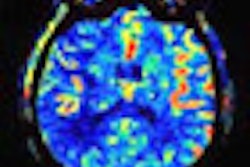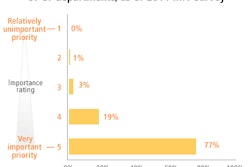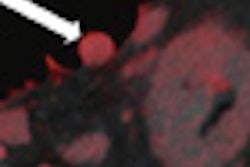CT is highly sensitive and specific for identifying acute appendicitis in both men and women, concludes a June 21 study in the Annals of Internal Medicine. In nearly 3,000 patients with suspected acute appendicitis, CT of the abdomen and pelvis appeared to reduce negative appendectomy and perforation rates.
Recent data from studies of patients who received an appendectomy also suggest benefits from increased use of MDCT, supporting its routine use for suspected appendicitis in adults, said researchers from the University of Wisconsin. However, surgery-based databases alone can't assess the sensitivity and specificity of MDCT because they exclude the larger nonsurgical cohorts in which imaging rules out appendicitis. Few MDCT studies have looked at CT's diagnostic performance in adults.
"High test sensitivity is critical to efficiently identify all patients who need appendectomy, but it is also desirable to avoid unnecessary surgical procedures," wrote Dr. Perry Pickhardt and colleagues (Annals of Internal Medicine, June 21, 2011).
The study analyzed MDCT findings and clinical outcomes of consecutive adults referred for MDCT for suspected appendicitis at a single academic medical center between January 2000 and December 2009. Patients 18 years and older who were referred for urgent care for any combination of signs and symptoms that raised concern for acute appendicitis, such as right lower-quadrant pain, fever, or leukocytosis, were included.
Radiologists performed general nonfocused imaging of the abdomen after administration of oral (n = 2,276, 79.3%), intravenous (n = 2,477, 86.3%), rectal (n = 12, 0.4%), or no (n = 272, 9.5%) contrast media. A static mA technique during the first few years gave way to modulated tube currents later on, and the typical effective dose was approximately 10 to 15 mSv acquired on four-, eight-, 16-, and, eventually, 64-detector-row scanners.
All CT scans were interpreted as 5-mm sections, which were reconstructed at 3- to 5-mm intervals. Thinner image reconstructions of the CT datasets were obtained as needed to more confidently identify the appendix.
Interpretations of nonfocused abdominopelvic MDCT scans were made by radiologists who were aware of the study indication.
The final surgical pathology report served as the reference standard for acute appendicitis, supplemented by the intraoperative findings or by clinical follow-up. The investigators performed a primary record review, characterizing patients as positive or negative without knowledge of the MDCT findings.
The results showed that 675 of 2,871 patients, or 23.5%, had confirmed acute appendicitis, with MDCT showing sensitivity and specificity of 98.5% and 98.0%, respectively. The overall rate of negative findings at appendectomy was 7.5% (54 of 716 patients).
Diagnostic performance of MDCT for suspected acute appendicitis
|
"It is noteworthy that preoperative MDCT interpretation was true-negative in nearly one-half of the clinically suspected cases in our series for which pathology findings were negative at appendectomy, outnumbering false-negative MDCT findings by 26 to 10," they wrote.
The 7.5% negative appendectomy rate would have decreased to 4.1% (28 of 690 patients) if MDCT had been relied on and surgery avoided in 26 cases with true-negative findings on MDCT. A 15% to 20% negative appendectomy rate was once considered acceptable, the authors noted.
The overall perforation rate was 17.8% (120 of 675 patients), but it progressively decreased from 28.9% in 2000 to 11.5% in 2009. In negative patients without appendicitis or appendectomy, MDCT suggested an alternative diagnosis in 893 of 2,122 (42.1%).
Although MDCT's performance did not significantly differ between men and women, women had a higher rate of negative findings at appendectomy than men (10.8% versus 3.7%, p = 0.003).
The results were limited by possible referral bias inasmuch as some patients who were difficult to diagnose clinically may not have been referred for MDCT, the authors noted.
"Our findings show that nonfocused abdominal MDCT is a highly sensitive and specific test for acute appendicitis in both men and women in whom it is clinically suspected," Pickhardt and colleagues wrote. "In this setting, MDCT can efficiently and effectively identify the approximately one-quarter of patients with actual appendicitis who need urgent surgery, and it can often identify a probable alternative cause of symptoms in those who do not have appendicitis."
Suspected nonappendiceal disease categories included acute gastrointestinal conditions (55.5%), gynecologic conditions (21.7%), genitourinary conditions (16.5%), and other acute conditions (6.3%), the authors reported.
The number of cases in which preoperative MDCT avoided an appendectomy that would have produced a negative finding "cannot be precisely determined, but the effect was probably substantial," the authors wrote.
"Our experience is similar to that of Rao and colleagues, but differs from that of Wagner and colleagues, in which only a few negative findings at appendectomy were true-negative CT findings," they wrote. "In their landmark study, Rao and colleagues showed that preoperative CT changed patient management in 59 of 100 cases, which was associated with a substantial savings in costs and resources."
"Our study, which to our knowledge represents the largest CT-based cohort for suspected appendicitis, shows a high sensitivity and specificity for MDCT, which corresponds to measurable clinical benefit," the group concluded. "In particular, the positive and negative likelihood ratios of 51.3 and 0.015, respectively, suggest that the CT findings should strongly influence management for both men and women, even those with a conflicting pretest clinical probability."




















